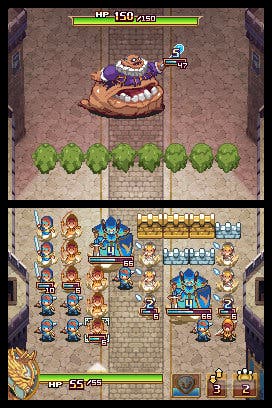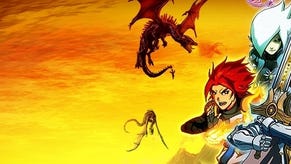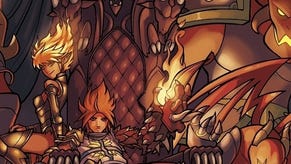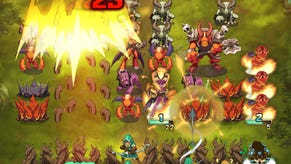Might & Magic: Clash of Heroes
Role-playing struzzlegy?
I've been having a lot of weird dreams recently. You know the sort - when you've been playing a game obsessively and its processes become so deeply infused with your thoughts that they infiltrate your consciousness at a very base level, giving you abstract and repetitive night terrors about making colourful elves stand in lines behind deer in dresses.
No? Well it happens to me. More so since I began playing and became thoroughly engrossed by Might & Magic: Clash of Heroes.
On the surface it's a familiar concept - put things in threes as much as you can before your opponent does, matching shapes and colours to each other to clear them. Set in the world of venerable PC series Might & Magic, there are elves and knights and demons and zombies. No one would blame you dismissed it as a cookie-cutter DS puzzle title. But you shouldn't do that, because developer Capybara, the team behind the awesome Critter Crunch, has crafted a real gem from a largely redundant old IP.
Firstly, any veterans of the Heroes of Might & Magic series would do well to leave expectations at the door (and sorry about the "largely redundant" thing, by the way). You will be familiar with the factions of Haven, Sylvan, Infernal et al, but the role-play and turn-based battle strategy of the heroes series has been tempered and forged with a strong element of puzzle. Think Puzzle Quest but with soldiers in place of gems.

Players begin as the elfy Sylvans, with a complement of fast and basic troops. Your army is quickly expanded with two more types of basic soldier, each taking up one square of the playing field. Organise them in vertical lines of three, either in a Tower of Hanoi-style pick-and-drop or by removing soldiers in the way, and they will activate, charging up an attack over the next few turns to unleash on your enemy.
Attacking means shooting or charging upwards, haemorrhaging attack points as units plough through enemy formations and defences before carving whatever's left from the health bar of the opposing general. Activated units also soak up a lot more damage than individuals, making them as valuable for defence as attack. At this stage the only other option is to arrange your troops, each type assigned to one of the three colours available, in horizontal rows instead. Do this and they form a wall rather than an attack formation, protecting your hero, who's standing courageously at the back, from charging enemies.
Then it all gets a bit more complex. You're given Elite units, which come in all three colours and occupy two vertical spaces on the grid. They need two normal units of the same colour to be stacked behind them in order to charge, and can't be used in walls. They're more effective than the basic units though, as reflected by their increased charge time and limited numbers, and each has a special function - healing, enhancing, extra damage, bypass defences, that sort of thing.
A little later you'll be rewarded with your first Champion unit. These are the behemoths and dreadnoughts of the battlefield - dragons, ents, griffons and efeets, who each occupy a square space of four and require another four basic troops behind them to activate. Once they do, however, they tend to be powerful enough to end a battle, unless your opponent can hastily prepare a counterpart in his own ranks. Each faction also has unique properties for its walls, as well as a powerful spell, cast once a 'rage gauge' is filled by damage.
These three classes of unit, further divided into different varieties, already provide an excellent basis for a strategically developed battle system, offering as they do a variety of options for assault and rebuke, but Capybara has added yet another level of complexity.














